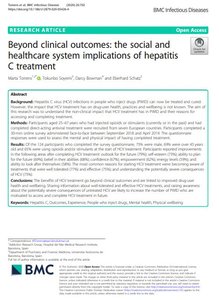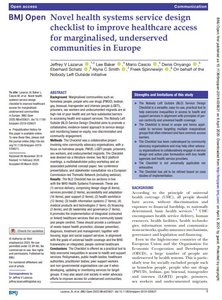Other policy issues
Beyond clinical outcomes: the social and healthcare system implications of hepatitis C treatment
Marta Torrens , Takunbo Soyemi , Darcy Bouwman , Eberhard Schatz
Background: Hepatitis C virus (HCV) infections in people who inject drugs (PWID) can now be treated and cured. However, the impact that HCV treatment has on drug-user health, practices and wellbeing is not known. The aim of this research was to understand the non-clinical impact that HCV treatment has in PWID and their reasons for accessing and completing treatment.
Methods: Participants aged 25–67 years who had injected opioids or stimulants (currently or in the past) and had completed direct-acting antiviral treatment were recruited from seven European countries. Participants completed a 30-min online survey administered face-to-face between September 2018 and April 2019. The questionnaire responses were used to assess the mental and physical impact of having completed treatment.
Results: Of the 124 participants who completed the survey questionnaire, 75% were male, 69% were over 45 years old and 65% were using opioids and/or stimulants at the start of HCV treatment. Participants reported improvements in the following areas after completing HCV treatment: outlook for the future (79%); self-esteem (73%); ability to plan for the future (69%); belief in their abilities (68%); confidence (67%); empowerment (62%); energy levels (59%); and ability to look after themselves (58%). The most common reasons for starting HCV treatment were: becoming aware of treatments that were well tolerated (77%) and effective (75%); and understanding the potentially severe consequences of HCV (75%).
Conclusions: The benefits of HCV treatment go beyond clinical outcomes and are linked to improved drug-user health and wellbeing. Sharing information about well-tolerated and effective HCV treatments, and raising awareness about the potentially severe consequences of untreated HCV are likely to increase the number of PWID who are motivated to access and complete HCV treatment in future.
Keywords: Hepatitis C, Outcomes, Experience, People who inject drugs, Mental health, Physical wellbeing
Novel health systems service design checklist to improve healthcare access for marginalised, underserved communities in Europe
Jeffrey V Lazarus , Lee Baker , Mario Cascio , Denis Onyango , Eberhard Schatz , Alyna C Smith , Freek Spinnewijn
Background: Marginalised communities such as homeless people, people who use drugs (PWUD), lesbian, gay, bisexual, transgender and intersex people (LGBTI), prisoners, sex workers and undocumented migrants are at high risk of poor health and yet face substantial barriers in accessing health and support services. The Nobody Left Outside (NLO) Service Design Checklist aims to promote a collaborative, evidence-based approach to service design and monitoring based on equity, non-discrimination and community engagement.
Methods: The Checklist was a collaborative project involving nine community advocacy organisations, with a focus on homeless people, PWUD, LGBTI people, prisoners, sex workers, and undocumented migrants. The Checklist was devised via a literature review; two NLO platform meetings; a multistakeholder policy workshop and an associated published concept paper; two conference presentations; and stakeholder consultation via a European Commission-led Thematic Network (including webinar). Results The NLO Checklist has six sections in line with the WHO Health Systems Framework. These are: (1) service delivery, comprising design stage (6 items), services provided (2 items), accessibility and adaptation (16 items), peer support (2 items); (2) health workforce (12 items); (3) health information systems (7 items); (4) medical products and technologies (1 item); (5) financing (3 items); and (6) leadership and governance (7 items). It promotes the implementation of integrated (colocated or linked) healthcare services that are community based and people centred. These should provide a continuum of needs-based health promotion, disease prevention, diagnosis, treatment and management, together with housing, legal and social support services, in alignment with the goals of universal health coverage and the WHO frameworks on integrated, people-centred healthcare.
Conclusions: The Checklist is offered as a practical tool to help overcome inequalities in access to health and support services. Policymakers, public health bodies, healthcare authorities, practitioner bodies, peer support workers and non-governmental organisations can use it when developing, updating or monitoring services for target groups. It may also assist civil society in wider advocacy efforts to improve access for underserved communities




